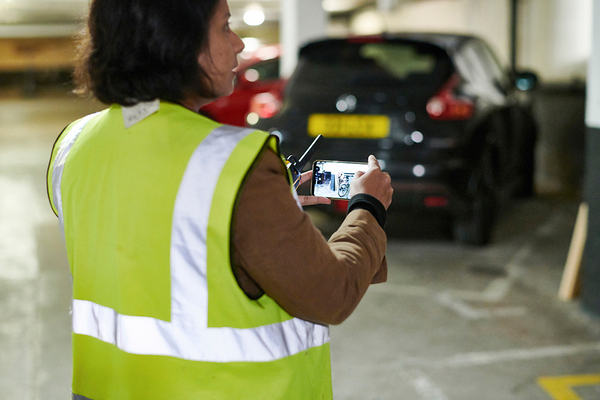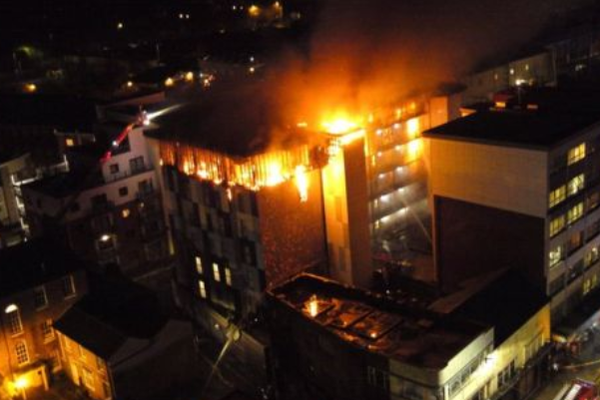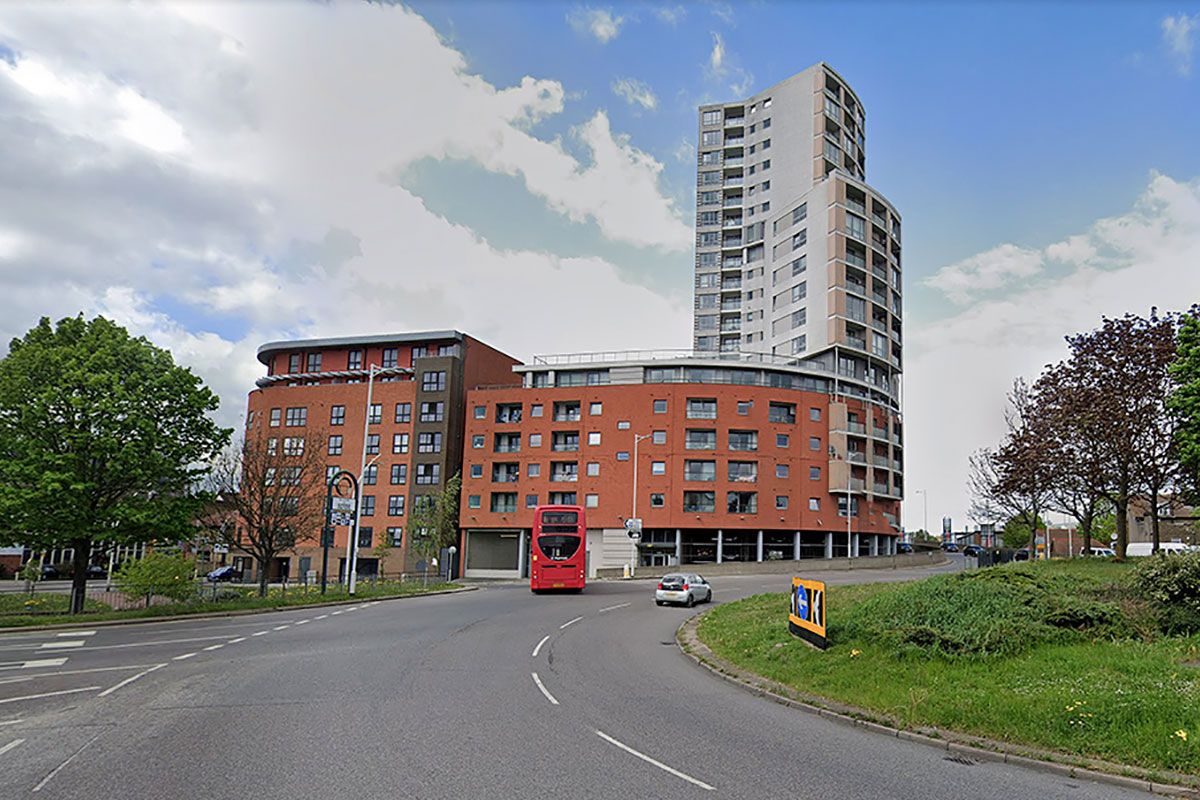You are viewing 1 of your 1 free articles
Waking watches: the scale of England’s building safety crisis unveiled
New Inside Housing research exposes the extent of the use of expensive ‘waking watches’ for the first time. Peter Apps goes through the details and finds out whether these services are working. Additional reporting by Nathaniel Barker. Illustration by Mark Long
From the outside, Raphael House looks like a run-of-the-mill development of new private flats, just off the high road in Ilford – an unpretentious part of east London on the border with Essex.
It is in fact one of the buildings around the country that has been caught up in the country’s escalating crisis over fire safety. Built in 2010 by Galliard Homes, it has an expanded polystyrene insulation system on its walls and missing fire breaks. This is deemed a substantial enough fire risk that residents need to evacuate immediately, rather than stay put, if a fire breaks out.
But the trouble is how to raise the alarm. Like almost all residential buildings around the UK, Raphael House was built without fire alarms, in accordance with official guidance that said they were unnecessary. And so a five-person 24-hour patrol was put in place in December, to seek out fires and raise the alarm if necessary. This service costs around £50,000 a month – a bill that is split between the 154 flats in the block, resulting in average costs of more than £300 a month each.
Paying these bills was always a struggle. But in the current climate, with many residents losing their jobs and income as a result of the economic turmoil caused by the coronavirus outbreak, it is unbearable.
“We feel like we are being cornered from all sides,” says one resident, who prefers to remain anonymous. “There really is not much light at the end of the tunnel.”
This experience is increasingly common. New research by Inside Housing has exposed the full extent of the use of waking watches around the country for the first time. Responses to Freedom of Information Act (FOIA) requests by 40 of the country’s 50 fire authorities reveal that fire services are aware of 420 live waking watches in their areas. Many have been in place for years, with some dating right back to June 2017, the month of the Grenfell Tower fire.
The figures also reveal that fire authorities have attended 300 fires at these blocks during the three years since Grenfell – a stark reminder of the game of Russian roulette the country is playing with the risk of a repeat disaster.
The reality of having so many buildings reliant on constant supervision is bleak: costs are spiralling out of control for the leaseholders and social landlords paying for them. There are also questions about whether they are truly keeping residents safe, given that the official guidance asserts that they should be temporary. And the outbreak of coronavirus has raised additional fears about how long they can carry on running.
The first question is: why have they been in place for so long? The official fire chiefs’ guidance that governs their use says that the presence of a waking watch with no alarm system is the “least reliable” means of providing warning in a fire, as well as being “the most resource intensive”. The guidance adds that it is “impracticable for a long-term solution and should only be a short-term measure”.
But this is not what is happening. Inside Housing’s research shows that waking watches have been in place for more than a year in dozens of fire authorities. In Tyne and Wear, Leicestershire, and Dorset and Wiltshire, there are live waking watches that date back to 2017. In London, where 289 watches are located, many stretch back years. Local authorities including Slough, Wandsworth, Camden and Manchester had watches from summer 2017 for more than two years, with some still in place.
So why have they not been replaced with alarm systems? The truth is that there has long been a resistance to fitting fire alarms in blocks of flats, which has been actively discouraged by official government guidance. This results from the reliance in the UK on the ‘stay put’ fire safety strategy for blocks of flats – the idea that only people in the flat the fire is in should evacuate and other residents should stay where they are unless and until
they are affected.
This strategy was the absolute cornerstone of fire safety in flats before Grenfell, and resulted in government-backed guidance published in 2011 that said fire alarms “should not be installed unless it can be demonstrated that there is no other practicable way of ensuring an adequate level of safety”. It described the fitting of alarms as “unduly pessimistic” even where there were direct concerns about construction quality and advised that changes should instead focus on returning the building to a standard where ‘stay put’ is possible.
This guidance is no longer considered comprehensive, but it does exemplify an attitude towards alarm systems that is fairly baked into the management of high rises. “There is a real barrier in the sector to putting alarms into blocks of flats,” says Phil Murphy, a fire safety consultant and retired firefighter.
A waking watch protects Raphael House in Ilford, which has an expanded polystyrene insulation system on its walls and missing fire breaks
Andrew Scott, a director at alarms company C-Tec and chair of a British Standards committee on fire detection and alarm systems, explains: “What they are afraid of is lots of false alarms, which would result in people ignoring the alarms.”
Mr Scott explains that the fire alarms industry is primarily guided by standards set in a document called BS-5839. There is no clear standard for what to fit in blocks of flats and part six of this guidance, which covers dwellings, actually makes it clear that communal areas of blocks of flats should not be fitted with them.
While other guidance has been published since Grenfell – by the Grenfell Tower Inquiry, the National Fire Chiefs Council (NFCC) and the government – the alarms industry is not always aware of this and therefore the products that are offered for blocks of flats can seem inappropriate.
“You don’t want a break-glass system in corridors that is going to get knocked by vandals, or by accident. You don’t want something that is going to go off if someone is smoking or burns a piece of toast,” he explains.
Mr Scott explains that alternative systems are out there, such as smart alarms with hush functions, or those that are activated by heat or multiple outbreaks of smoke – universally accepted ways of filtering out false alarms from actual fires. Smart alarms can evacuate parts of a building at a time, give varied instructions to residents and be monitored offsite.
But without specific, clear and official guidance about what is appropriate for blocks of flats, it is likely that many building owners are preferring to keep the waking watch in place until the cladding is removed and avoid the cost of installing a system that would eventually be removed once the remediation work was complete.
Number of waking watches per fire authority and number of fires attended
Click on any column header to sort
| Fire authority | Waking watches | Length of time (if provided) | Fires |
|---|---|---|---|
| London | 289 | 263 | |
| Greater Manchester* | 57 | ||
| Mersey | 9 | They range from June 2018 to February this year | 1 |
| West Midlands | 8 | November 2019 to January 2020 | 4 |
| Cheshire | 7 | October 2019 (all) | 4 |
| Hampshire | 7 | Most have been in place since October and November 2019 | 2 |
| Essex | 6 | 3 | |
| Cleveland | 6 | Since August 2019 and December 2018 | 0 |
| Lancashire | 5 | 7 | |
| Tyne and Wear | 4 | Two have been in place since June 2017, one since December 2017 and one since November 2019 | |
| Northumberland | 3 | Two have been in place since April 2018 and one since December 2019 | 2 |
| Buckinghamshire | 3 | Two have been in place since October 2019 and one since August 2019 | 5 |
| Surrey | 3 | 1 | |
| Warwick | 3 | Since May 2019 | 0 |
| Northants | 2 | Since August 2019 | 4 |
| Kent | 2 | Since December 2019 | 1 |
| Leicestershire | 1 | Since 2017 | 0 |
| Suffolk | 1 | Since February 2020 | 0 |
| West Sussex | 1 | Since January 2020 (overnight only) | |
| Dorset and Wiltshire | 1 | Since December 2017 | 2 |
| Nottinghamshire | 1 | 0 | |
| Hertfordshire | 1 | Since June 2019 | 1 |
| Total | 420 | 300 |
Notes: The following fire authorities said they currently have no waking watches: Shropshire, Staffordshire, Guernsey, Norfolk, Bedfordshire, Lincolnshire, Oxfordshire, Isle of Scilly, Cornwall, Durham and Darlington, Avon, Humberside, North Yorkshire, Cambridgeshire, Derbyshire, and Devon and Somerset. Fire authorities for East Sussex and Scotland said they do not record a figure. Greater Manchester Fire and Rescue service did not respond to the FOIA request, but the figure was taken from a report of the Greater Manchester Combined Authority taskforce on fire safety. It is the total number of buildings with ‘interim fire safety measures’ – the majority of which are understood to involve waking watches.
Source: Responses to Inside Housing FOIA requests, February and March 2020
With the widely publicised delays in remediation work, this strategy means waking watches become a permanent fixture. This is a worry. The NFCC’s guidance is clear that waking watches should be temporary, and whether a group of poorly paid security workers can evacuate hundreds of residents from a building in 10 minutes is doubtful.
It has been done: Inside Housing has seen evidence of successful evacuations led by waking watches in a housing association block in Plymouth. But it has also failed. In Vallea Court in Manchester, the waking watch was unable to warn all residents about a fire in May 2019.
This is not to blame the watchers themselves. As Mr Murphy says: “When I left firefighter training we were told, ‘You are the only people in the country who will run into a burning building.’ Asking someone to do it after half a day’s training isn’t just unsafe, it’s unethical.”
That said, horror stories about waking watches do abound. In one building in the North West, a resident describes their first waking watch service as “absolutely horrendous”. The resident says: “They were regularly seen asleep, watching TV and watching porn. After one week they still had not watched one whole half of the building – because it had not occurred to them to go around the back.”
This provider was replaced, but the replacement is still not perfect. “There is at least one person who spends the majority of his time smoking in the courtyard, specifically in the area where leaseholders have been prevented from parking their cars due to the fire risk,” the resident adds.
A few weeks ago an alarm went off in the temporary building where the waking watch is located. The residents decided to evacuate, but there was no sign of the watchers. These residents are facing one of the highest bills in the country for the service: it will average £840 each per month when it lands, with the bill for the first quarter of 2020 due imminently.
In Islington Gates, in Birmingham, Inside Housing has seen a breakdown for three leaseholders which shows they are paying £212, £349 and £563 a month respectively for waking watches, with even higher bills for insurance premiums.
What is a waking watch?
In the immediate aftermath of Grenfell, 24-hour security patrols were introduced in a number of buildings known to have similarly dangerous cladding. This was formalised with the publication in October 2017 of guidance by the National Fire Chiefs Council for buildings requiring ‘simultaneous evacuation’ as a result of fire safety defects.
In that guidance, a ‘waking watch’ is defined as “a system whereby staff continually patrol all floors and the exterior perimeter of the building in order to respond to a fire, assist in calling the fire service and assist with the evacuation of occupants of the building”.
They are tasked with alerting all occupants to a fire requiring evacuation within 10-15 minutes of detecting it. This can be done by either activating a manual alarm or knocking on doors and sounding an air horn if no alarms are installed.
The guidance warns that this “is likely to be the least reliable [safety measure], most resource intensive, and may not be suitable for the highest-risk situations”. It adds that it is “impracticable for a long-term solution and should only be a short-term measure”.
In practice, waking watches are delivered by security agencies that charge a fee to the building owner for the 24-hour service.
These costs are high, but not unheard of. In the social housing sector, the figures being spent are eye-watering. Camden Council, for example, has spent more than £10.2m on waking watches across nine blocks, with the service in place from June 2017 to December last year.
In total, the 35 local authorities that responded to Inside Housing’s FOIA requests had spent £29.4m on waking watches for 134 council blocks over a varying period of time. Housing associations, for whom figures under the FOIA are not available, are spending similarly devastating sums: one source at an association quotes a figure of £30,000 a week. This is all money that has come directly out of budgets to repair social homes and build new ones.
But the costs are most devastating for individual leaseholders. In the worst cases, these can reach £800 a month, but an average figure is around £400. These are on top of bills for cladding removal and additional insurance premiums – adding up to service charge increases of thousands of pounds every year. These are costs that people cannot meet.
And the costs do not always end when an alarm system is fitted. Ritu Saha is a resident of the Northpoint building in Bromley, south London. She tells Inside Housing that a simultaneous evacuation fire alarm was fitted in July 2019, with the £120,000 cost split between the building’s 57 households. But residents then discovered that someone must be on site 24/7 to monitor and deactivate false alarms, to lessen the call-out burden on the fire service.
Residents began doing this themselves, but their insurer insisted that someone must be employed for the task. This costs £11,000 a month, resulting in an average £200 monthly increase in service charges.
“It effectively means we have to pay for a 24-hour concierge service,” Ms Saha says. “If that does not change, it’s finished. Nobody in Bromley is going to be able to afford to pay service charges like that so nobody will buy the flat.”
Fires attended at blocks in London that currently have a waking watch since June 2017
| Council | Count of fires since 2017 |
|---|---|
| Barking & Dagenham | 4 |
| Barnet | 3 |
| Bexley | 1 |
| Bromley | 1 |
| City Of London | 1 |
| Croydon | 9 |
| Ealing | 5 |
| Greenwich | 18 |
| Hackney | 39 |
| Harrow | 2 |
| Hillingdon | 1 |
| Hounslow | 1 |
| Islington | 10 |
| Kensington & Chelsea | 3 |
| Lambeth | 2 |
| Lewisham | 10 |
| Newham | 19 |
| Redbridge | 1 |
| Richmond | 1 |
| Sutton | 26 |
| Waltham Forest | 1 |
| Wandsworth | 14 |
| Wembley | 1 |
| Brent | 26 |
| Camden | 5 |
| Fulham | 2 |
| Havering | 7 |
| Southwark | 14 |
| Tower Hamlets | 23 |
| Westminster | 13 |
| Total | 263 |
Source: London Fire Brigade
This cost pressure comes at a time when people are uniquely precarious and vulnerable when it comes to their finances because of the economic meltdown resulting from the coronavirus pandemic.
“Many leaseholders are not able to afford existing payments and many more will not be able to afford any further costs due to increased waking watches,” says the resident from Raphael House in Ilford. “Many are having mental health issues due to the constant stress, which is amplified by COVID-19. Many will lose jobs.”
New NFCC guidance, specifically about waking watches and coronavirus, warns that the services remain “essential” during the outbreak. There are concerns that staffing numbers could dry up, but these fears are muted at the moment.
A source at a large London housing association says: “It’s something everyone is focused on at the moment. We’re monitoring it on a daily basis and across the G15 [group of large London landlords] everyone has full coverage. There isn’t an issue with supply of labour yet. My impression is that people want to get out of the house and want to get paid.”
The government has also confirmed that waking watch staff are key workers, and can continue to work during the lockdown and send their children to school.
This may, of course, change as more people become unwell, but a source from Manchester is also relatively relaxed about staffing levels. “I don’t see they will be massively impacted now pubs and clubs have been closed, as many are provided through security companies,” they say.
There are additional concerns about spreading the virus. One leaseholder comments: "Because the nature of waking watch is to go from door-to-door constantly we have raised the concerns of spreading Covid 19 within the building as they had no gloves or sanitiser. And only an external portaloo for hand washing with no hot running water." Mr Murphy suggests watchers could be provided with spray detergent to clean as they go, but it is not thought this in place anywhere yet.
There are also fears that the lockdown will slow work to fit alarms and remove cladding, meaning waking watches and the resultant costs stay in place for longer. With the economy grinding to a halt and workers being forced off many cladding remediation sites despite government advice that they should stay open, this sadly looks a likely outcome.
It appears this stopgap solution will be a feature of life in many buildings for quite some time yet.
Waking watches in council-owned tower blocks (including contractor and cost)
Click on any column header to sort
| Local authority | Number of blocks | Cost (total) (£) | Cost (per block) (£) | Length of time | Contractor | Number of fires |
|---|---|---|---|---|---|---|
| South Tyneside | 12 | 19,323 | 1,610 | Tyne Tees Security | 0 | |
| Kensington & Chelsea | 11 | 4,932,623 | 448,420 | Until Aug 2019, three still in place | Event Fire Solutions, Oracle, Vigilant Security | 4 |
| Camden | 9 | 10,205,119 | 1,133,902 | Jun 2017 to Dec 2019 | 5 | |
| Salford | 9 | n/a - provided by Pendleton Together | Still in place | 1 | ||
| Southampton | 8 | 280,000 | 35,000 | For five weeks in early 2018 | CLC Group plus some in house | 0 |
| Barnet | 6 | 487,100 | 81,183 | Three still in place | STM Group UK/Keepmoat (part of cladding works) | 0 |
| Lambeth | 6 | 109,191 | 18,199 | For only a few weeks each | 0 | |
| Westminster | 6 | 946,200 | 157,700 | No longer in place | Event Fire Solutions | 0 |
| Hillingdon | 5 | 324,248 | 64,850 | Six months each | Kingdom Services Group, Scaffolding Access | 0 |
| Rugby | 5 | 1,383,073 | 276,615 | Two ended in Dec 2019 after decant | Stonewall | 0 |
| Southwark | 5 | 2,966,021 | 593,204 | Kier Facilities Services | 2 | |
| Bournemouth | 4 | 15,268 | 3,817 | Insight Security | 0 | |
| Croydon | 4 | 850,657 | 212,664 | 0 | ||
| Gateshead | 4 | 42,312 | 10,578 | Ended in Sep 2019 | Orbis | 0 |
| Manchester | 4 | Private finance initiative | Jul 2017 to Dec 2018 | 0 | ||
| Sandwell | 4 | 49,646 | 12,412 | For five weeks in 2017 | Mitie Security | 0 |
| Sutton | 4 | 259,790 | 64,948 | Still in place | No contractors but temporary staff | 2 |
| Hounslow | 3 | 35,520 | 11,840 | A few weeks each | Enigma Security Solutions | 0 |
| Enfield | 2 | 374,250 | 187,125 | Both now ended | Event Fire Solutions | 0 |
| Greenwich | 2 | 24,192 | 12,096 | 13 months up to Aug 2018 | Global Guardians Management | 0 |
| Islington | 2 | 885,475 | 442,737 | Ended in Jun 2019 | Some in house, the rest CIS Security | 2 |
| Poole | 2 | Contractor bore costs | ||||
| Portsmouth | 2 | 663,412 | 331,706 | Until Aug 19 | MG Security/Mountjoy | 0 |
| Slough | 2 | 1,347,703 | 673,851 | In place Jun 2017 until Dec 2019 | Manpower | 0 |
| Stoke-on-Trent | 2 | 92,272 | 46,136 | CBI Security Services | 0 | |
| Wandsworth | 2 | 1,362,042 | 681,021 | Since Jun 2017. One ended Nov 2019 | Parkguard, plus in house | 0 |
| City of London | 1 | 319,848 | 319,848 | No longer in place | Noonan Services Group | 0 |
| Folkestone & Hythe | 1 | 3,795 | 3,795 | 10 days in Nov 2019 | Prevention and Detection Services | 0 |
| Hackney | 1 | 640,000 | 640,000 | Apr 2019 to Jan 2020 | Triton UK | 0 |
| Kirklees | 1 | 48,000 | 48,000 | Since Dec 2019 | Kings Contractors | 0 |
| Leicester | 1 | 60,048 | 60,048 | Still in place - three-storey homeless hostel | In house | 1 |
| Mansfield | 1 | 224,640 | 224,640 | Urban Security Guards | 0 | |
| North Tyneside | 1 | Not known | Not consistently | In house | 0 | |
| St Albans | 1 | 236,610 | 236,610 | End of Jan 2020 | Black and White Key Security | 0 |
| Welwyn Hatfield | 1 | 189,728 | 189,728 | Still in place | 0 |
Source: Responses to Inside Housing FOIA requests, January and February 2020














